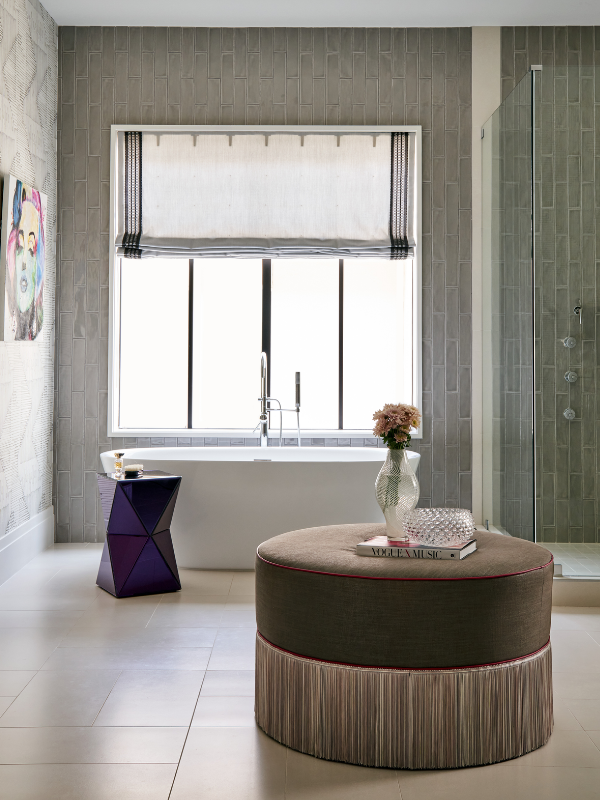Back in 2022, Laura U Design Collective collaborated with partners Perennials and KURFI to select the perfect window treatments for our Mountain Lane Show House—many of which were Roman shades. Since then (and long before), we have selected Roman shades for a wide variety of projects because they are versatile, easily maintained, and an incredible opportunity to add texture, pattern, and movement to a space.
Both modern and classic, Roman shades can add either whimsy or elegance to a space. They can be sleek and streamlined or ornate and maximalist, soft and relaxed or curated and constructed. Given their aesthetic appeal and many practical applications, onlookers will find these versatile window treatments throughout our portfolio—from Pebble Beach to Hedwig Village to our most recent Garden Oaks renovation.
Of course, there are many ways to style Roman shades and dozens of patterns to pick from. In this post, we offer a few of our top tips for selecting the right style for your home’s interior. We also outline the different fold styles and pairing options for Roman shades. Follow below to learn exactly how to choose Roman shades like a designer!
What Are Roman Shades?

Most fabric window treatments fall into two categories: shades and drapery. Often paired with drapes, Roman shades are perhaps the most popular type of shades for window treatments. This is because they fit most window types—from bay to casement—and mesh with many aesthetics.
Homeowners often confuse fabric Roman shades for roller shades despite a few key differences between the two. In her House Beautiful article “The Right Window Treatment for Every Room,” Hadley Keller explains how the two shade styles diverge from one another.
DISTINGUISHING BETWEEN ROMAN SHADES AND ROLLER SHADES

Quoting Adam Skalman of The Shade Store, Keller writes that roller shades “‘have a minimalist look and feel.'” Unlike most Roman shades, roller shades are completely flat with no pleats or seams. Roller shades consist of a single piece of fabric that rolls around a tube at the top of the window. That tube is typically concealed with a casing.
Because of this, roller shades are often found in minimalist interiors. When found in maximalist interiors, roller shades usually “‘showcase beautiful textures and patterns.'” These prints would otherwise be interrupted by a pleated shade or draped curtain.
Roller shades can be very practical, but they lack the soft, layered look of Roman shades and might feel too stark in traditional or eclectic interiors.

Roman shades, on the other hand, “‘blend the softness of drapery with the functionality of shades.'” Uniquely versatile when compared to other window treatments, Roman shades are each “‘crafted to control light and frame your windows in their own way.'”
Roman shades can be relaxed and casual, formal and traditional or crisp and contemporary. With many fold styles available, Roman shades can either display a delicate design or boast a bold, large-scale pattern. Without the need for decorative rods, valances or finials, custom Roman shades can fit nearly any type of window.
DIFFERENT FOLD STYLES OF ROMAN SHADES
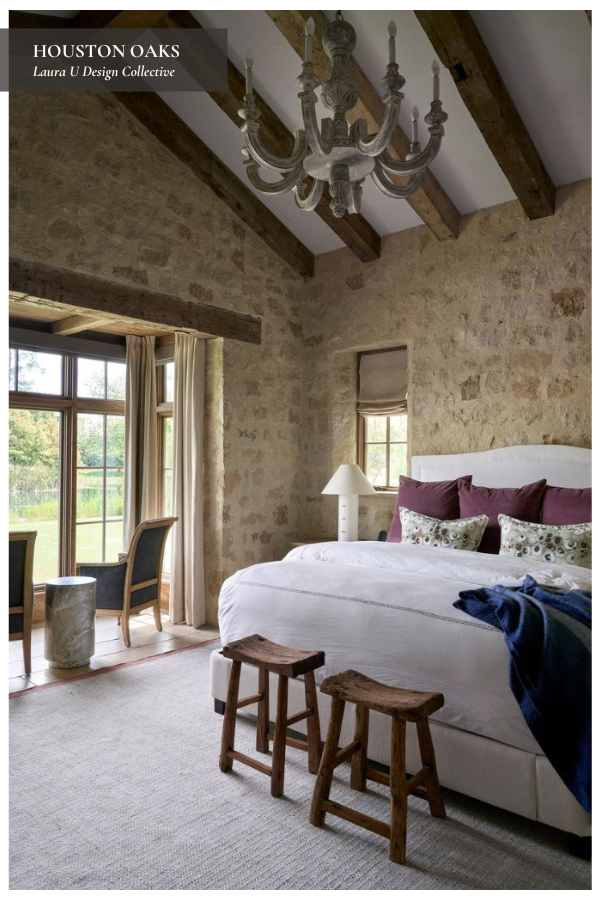
In many of our projects here at LUDC, our team opts for clean fold styles that show off the patterns and fabrics of each Roman shade or softly draping styles that have a gently romantic feel to them. However, there are a number of other Roman shade fold styles to choose from when designing window treatments. From flat and plain folds to European and hobbled folds, we explain each fold style below.
Soft or Hobbled Roman Shades
Hobbled Roman shades—also called “soft fold” Roman shades—are beloved for the romantic look they create. This billowy effect can be absolutely lovely. However, the extra fabric between each roll can be bulky and overwhelm smaller windows. Because of this, designers usually recommend hanging hobbled or soft Roman shades over windows with deep sills.
Classic or Flat Fold Roman Shades

The modern Roman shades chosen for the kitchen of our Mountain Lane Show House were crafted from Perennials’ Tribal Trellis fabric in Nickel. This acrylic performance fabric was also chosen for the living room pillows.
By contrast, flat fold Roman shades are seamless and most closely resemble roller shades. Because these Roman shades feature a single seamless piece of fabric rather than a series of sewn pleats, they are best for large-scale prints. They usually offer a clean and classic look. However, flat Roman shades can occasionally clump, tilt or shift because the folds are not permanently sewn in place.
Unlike hobbled Roman shades, flat fold Roman shades are perfect for French doors and shallow windows. Most of the shades chosen for our Mountain Lane Show House are flat folded to maintain a sleek, sophisticated look throughout the home.

Plain Fold or Pleated Roman Shades
Pleated or plain fold Roman shades are kind of like a cross between hobbled and flat fold Roman shades. Seamed every few inches, plain fold Roman shades do not bunch unevenly like flat fold Roman shades. Unlike hobbled shades, they do not overwhelm small shallow windows with rolls of extra fabric.
In this way, plain fold or pleated Roman shades are the best of both worlds. We love the plain fold style of Roman shades when working with monochromatic or color-blocked fabrics because the pleats add much-needed visual interest.
European or Relaxed Roman Shades
Somewhat uncommon in 2024, relaxed Roman shades form a slouchy U-shape at the base. You might find relaxed Roman shades in casual settings like kitchens, breakfast nooks and bathrooms.
London or Scalloped Roman Shades
London or scalloped shades resemble both balloon shades and relaxed Roman shades. Both London and relaxed Roman shades slouch in the center. However, London shades have a draw on either side that causes the fabric to bunch on the left and right. London shades are sometimes called “tulip” shades because of the scalloped shape they create along the bottom when drawn.
Balloon Roman Shades
Like London shades, balloon shades are corded. Rather than a draw on either side of the shade, balloon shades feature many pleats. Each pleat curves at the bottom in a U-shape. Balloon shades can be either carefully tailored or casually bunched. This is considered a traditional, somewhat old-fashioned style of folding Roman shades.
Why We Love Roman Shades
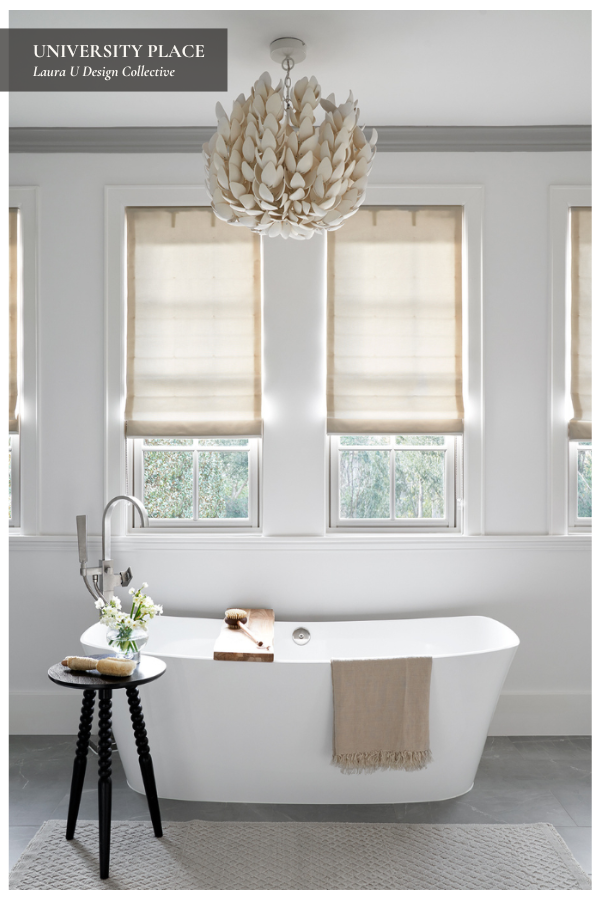
Roman shades are a popular choice among interior designers because of their versatility, elegance, and ability to suit a wide variety of aesthetics. They effortlessly balance form and function, which adds softness and sophistication to spaces while serving practical purposes like light control and privacy. Below are a few of the many reasons we love Roman window shades as designers.
ADAPTABILITY ACROSS STYLES AND SPACES
Roman shades are chameleonic in design. Designers can tailor them to fit any aesthetic, from modern minimalism to transitionalism. Whether it’s a relaxed fold on a soft fabric for a cozy breakfast nook or a flat fold with a bold pattern for a sleek living room, Roman shades adapt beautifully to different environments. Their compatibility with windows of all shapes and sizes—from bay windows to French doors—means that Roman shades work even in the trickiest layouts.
ENDLESS CUSTOMIZATION OPTIONS
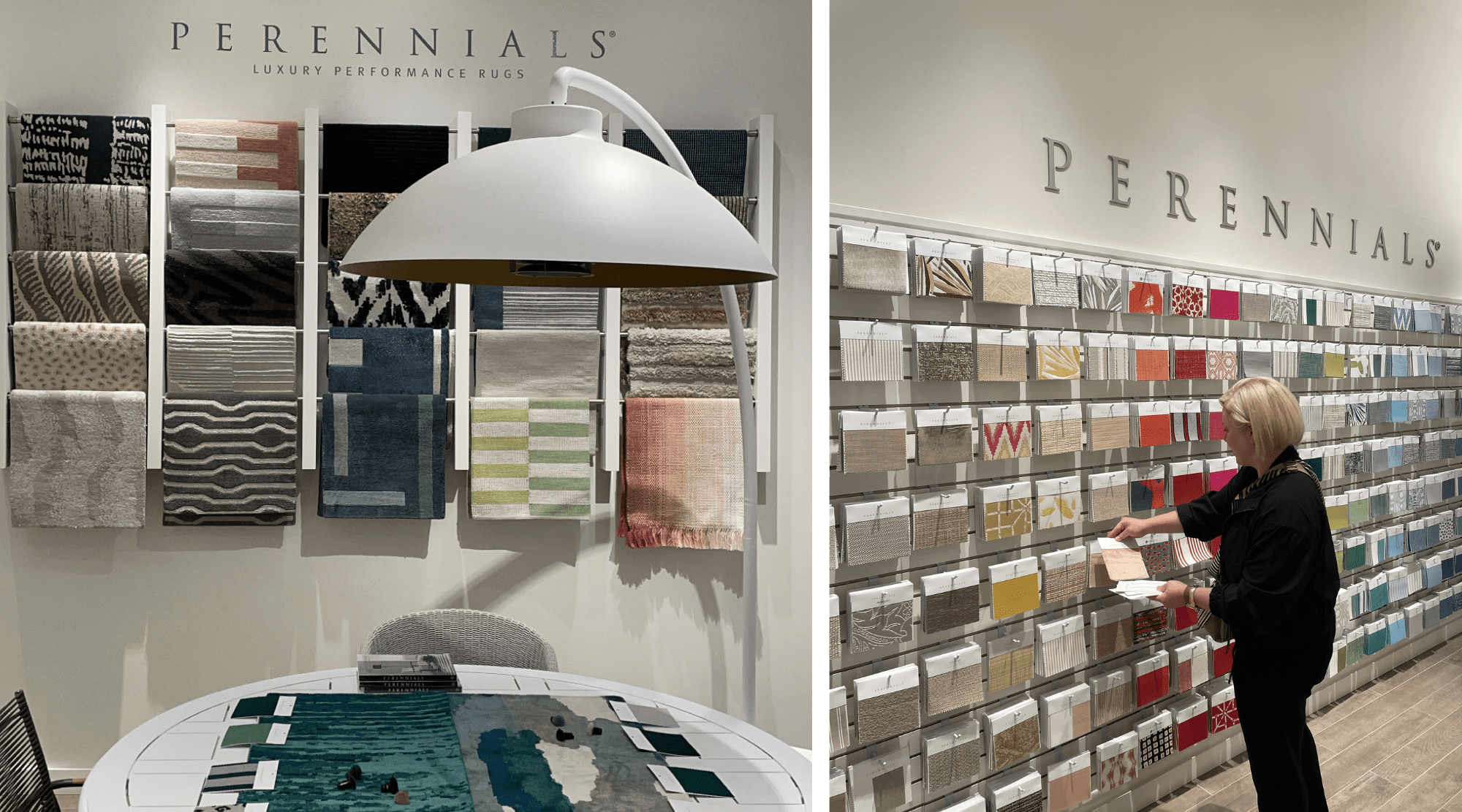
The customization possibilities with Roman shades are virtually endless. Designers can select from a variety of fold styles, patterns, and fabrics to achieve the desired look and feel. Whether it’s a delicate print for a nursery or a high-performance fabric for a mudroom that’s put through the wringer each winter, Roman shades are both beautiful and durable.
A SUPERIOR BLEND OF SOFTNESS AND STRUCTURE
Roman shades combine the softness of fabric with the clean lines of shades, making them a unique choice that adds warmth without overwhelming a space. They are especially useful in rooms where heavy drapes might feel excessive or roller shades too stark.
AN OPPORTUNITY TO CREATE VISUAL INTEREST
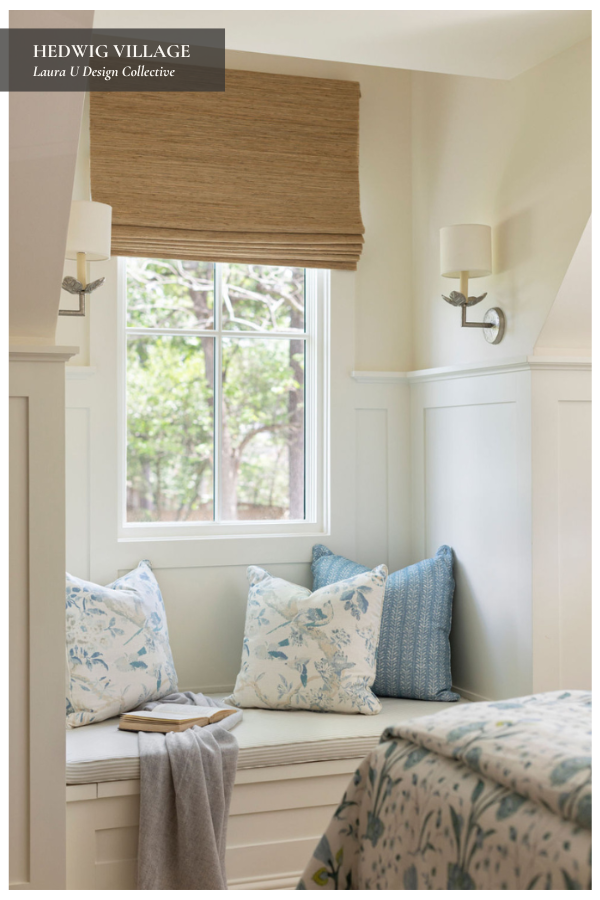
From bold, large-scale prints to subtle textures, Roman shades can serve as a statement piece or a complement to existing decor. They allow designers to experiment with layering by pairing shades with drapery or leaving them standalone for a minimal look.
PRACTICALITY

Beyond their beauty, Roman shades are also practical. They might not be as easy to take down and wash as other window treatments, but their sleek design means that Roman shades can be gently dusted or vacuumed using a brush attachment while still hanging. Select performance fabrics, and you will never worry about keeping this type of window covering clean.
If you opt for a denser fabric instead of a sheer one, Roman shades help with room darkening, too. Plus, they fold neatly away to ensure they never obstruct views or block natural light when not in use.
ABILITY TO ENHANCE ARCHITECTURAL FEATURES
Roman shades can highlight architectural details like decorative window casings or create the illusion of taller and wider windows with strategic mounting. When your designer opts for an inside mount, Roman shades allow your home’s decorative elements like casings, moldings, and trim to remain fully visible. This is ideal for homes with ornate or custom millwork. Unlike heavier treatments like drapery, these window shades showcase architecture details rather than obscuring them.
Roman shades can also help correct visual imbalances or modernize older elements in a room by adjusting how windows are perceived. For example, if a window is too small for the scale of the wall, your designer can opt for an outside mount to make the window appear larger. If you prefer a more contemporary look but live in a historic home with ornate woodwork or plaster detailing, sleek flat-fold Roman shades can simplify the program.
When to Choose Roman Shades vs. Drapes for Window Treatments

Because of the many fold styles available, Roman shades are suitable for bay windows, casement windows, French doors and more. Roman shades are ideal for oddly shaped windows and those in hard-to-reach areas of the home. When mounted inside the window frame, Roman shades show off decorative molding. When one mounts Roman shades outside the frame, they add visual impact an otherwise uninteresting window.
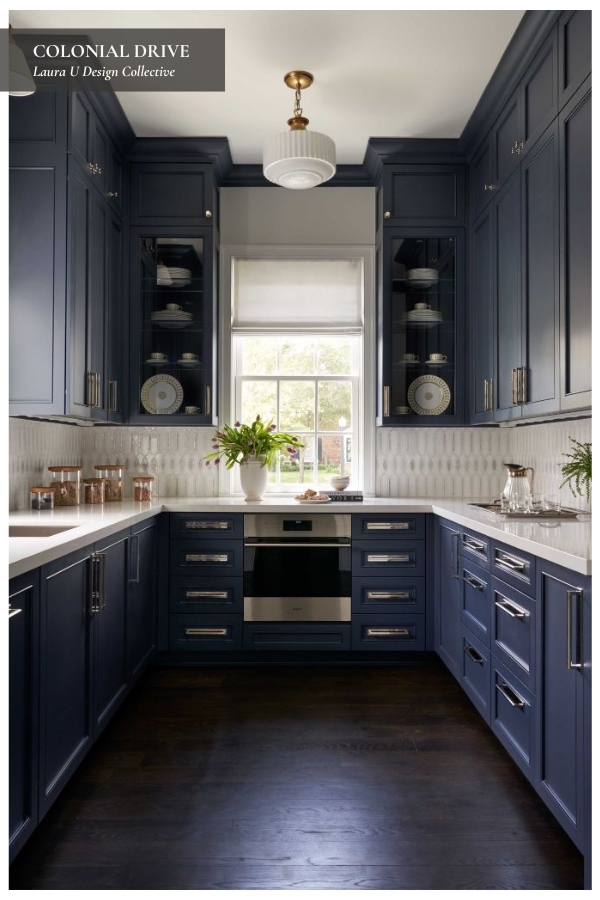
Though Roman shades are incredibly versatile, there are a few situations in which we would typically recommend drapes or roller shades. For example, floor-to-ceiling windows in modern interiors might be better served by sleek roller shades. Conversely, long drapes might be more appropriate for windows in rooms with low ceilings.
USING ROMAN SHADES IN TRICKY SITUATIONS
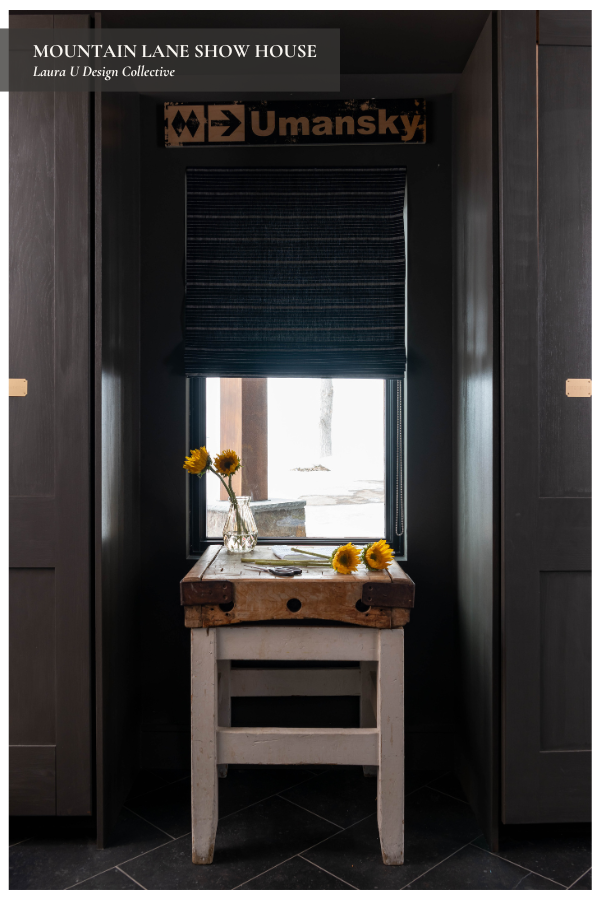
In the mudroom of the Mountain Lane Show House, we chose Kufri’s Cusco Stripe in Black. For the bay window in Liv’s bedroom, the LUDC team chose Rough Outline fabric in Blanca from Perennials.
Roman shades can still work beautifully in awkward spaces if the right fold style and fabric are selected. For example, flat-folded Roman shades in a zigzag pinstriped fabric can create a sleek, tailored look. Choosing a fabric with vertical stripes can trick the eye into making windows appear taller than they actually are.
To further elongate the window, follow advice from New Canaan designer Michelle Morgan Harrison. Quoted by Michelle Higgins in an article for The New York Times, Harrison recommends mounting Roman shades “at least six inches above the casing.” This way, the shade visually extends the top of the window frame. Better yet, “when the shade is up it doesn’t block the light.”
In the mudroom, we took a similar approach—but for a different effect. To create the illusion of a wider window, we opted for the horizontal Cusco Stripe fabric in Black from Kufri. Horizontal stripes are especially stunning in a flat fold Roman shade because the folds line up beautifully with the stripes.
HOW TO CHOOSE FABRICS FOR ROMAN SHADES

When choosing fabric for custom Roman shades, be sure to consider various weights, textures and patterns. In his article “Design Tips: When to Use Roman Shades” for Architectural Digest, Tim McKeough explains. Quoting window treatment expert Abby Rodriguez, McKeough writes that “‘light and medium-weight materials are fine’” for any fold style of Roman shade.
However, designers and homeowners alike should “‘avoid very heavily embellished fabrics or those that are just too rigid.’” This is because too much ornamentation and/or stiffness can affect the way the fabric folds.
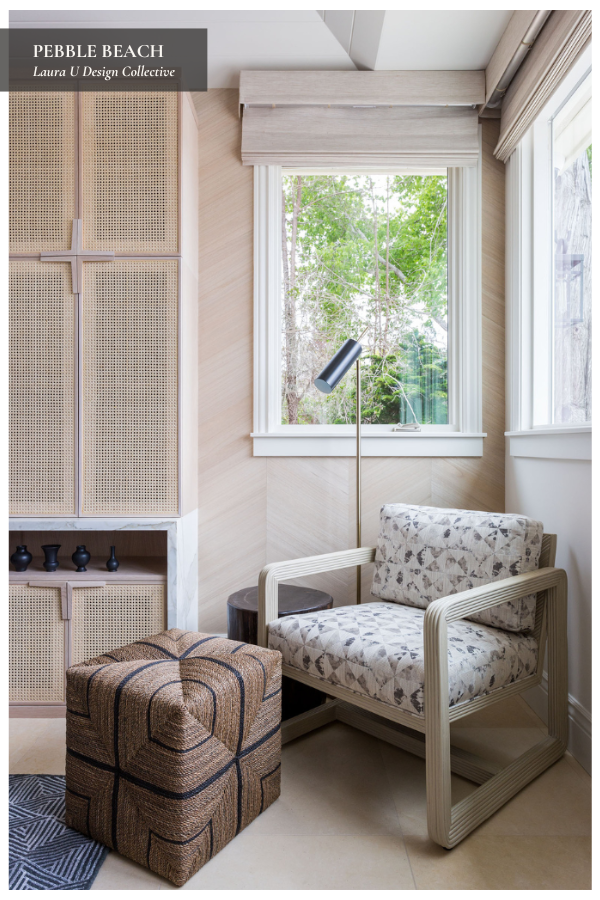
Rodriguez explains that “‘you want the folds to lie nicely one on top of the other.'” The thicker and stiffer a fabric is, “‘the harder that is to achieve.’” To ensure the fabrics you love are well-suited to Roman shades, Rodriguez recommends folding each fabric a few times. This way, you can see how each “‘reacts to being molded.'” Fabrics that puff up and refuse to lay flat probably are not the right choice for a sleek Roman shade.
Let’s Transform Your Home Together
At Laura U Design Collective, we understand that designing a home is creating a space that works harmoniously with the light, energy, and flow of your life. Whether selecting the perfect Roman shades to control heat and light or finding the right balance of texture and pattern to elevate your interiors, our team brings a deep understanding of how to craft spaces that are just as functional as they are stunning. If you are ready to transform your home with thoughtful design, reach out—we would love to help you create a space that perfectly suits your unique aesthetic and lifestyle.



